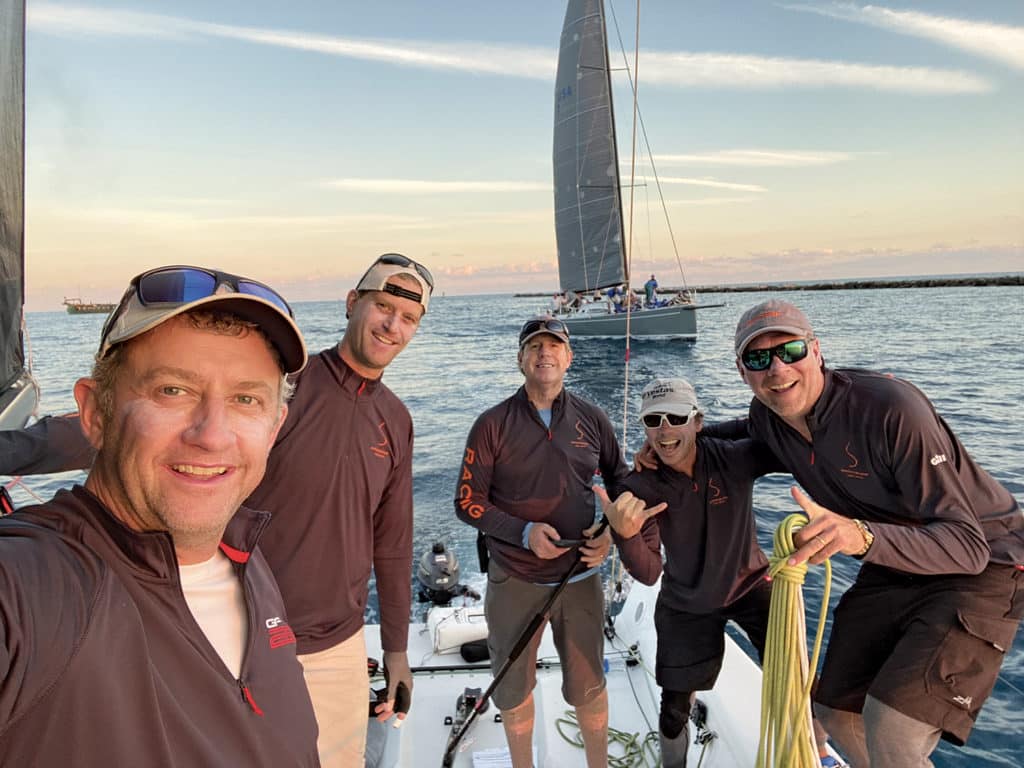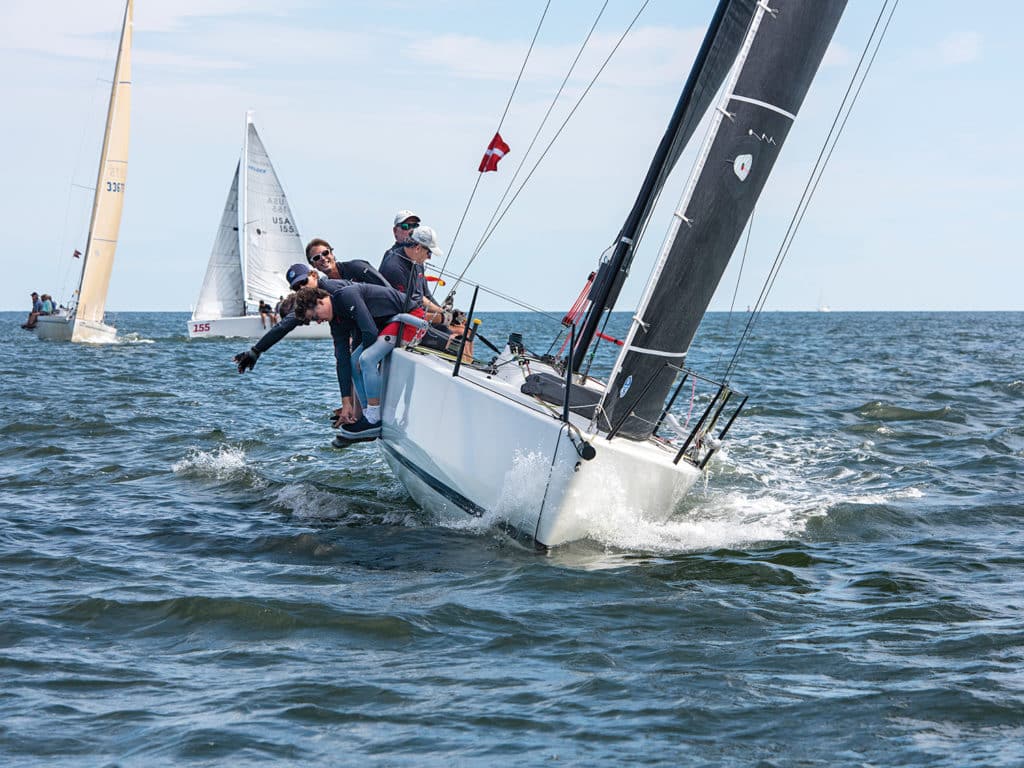
Paul Sevigny is on a mission. He wants to slay giants and, along the way, revolutionize the handicap racing scene in America. How’s he going to do that? Win a world championship in a sporty 26-footer, taking down the most expensive and best-prepared racing machines around. The arena for this sailing battle of the ages will be Rhode Island Sound, venue for New York YC’s 2020 ORC/IRC World Championships in early October.
He will be stepping onto the battlefield not only for himself and his teammates from Noroton, Connecticut, but also for the good of the common beer-can racing sailor. Should he emerge victorious, he hopes to inspire local handicap racing teams to step up and travel to race weeks, as many big-boat teams did 20 to 30 years ago before the proliferation of smaller, turnkey one-design classes that live on trailers.
I once thought he was nuts. But then I sailed with him.
“You can race with the big boys for a fraction of the cost with a small sporty boat,” Sevigny says. He bought his GP26 Smokeshow in spring 2019. “A [used] $14,000 Melges 24 might not be competitive in one-design. But in PHRF or ORC, you might have yourself quite a rocket ship.”
He reasons that adding crew and new sails, and optimizing the design for handicap racing, are simple upgrades. “When your boat costs less than most top guy’s mainsails, you have a little change left to try things. And now you can race against big teams. Isn’t that wonderful?”
I fall under Sevigny’s spell in fall 2019, during the daylong Denmark Race on Long Island Sound. When I first meet him, the boat is under the hoist at Noroton YC, surrounded by a monolithic fleet of Sonars. It looks like a miniature TP52, all tricked out with control lines and high-tech sails. We cram six sailors into a cockpit that is no bigger than a solo sailor’s Mini, and over the course of a breezy afternoon—pulling plenty of power from the boat’s asymmetric spinnakers and code sails—we hoot and plane to second overall, ahead of several 45-footers.
Though the experience is fun, I don’t see a GP26 future in my career, until Sevigny bends my ear about his goal to win the ORC/IRC World Championship. Now I’m listening.
Over dinner on a frigid November night in Newport, Sevigny is determined to get me on board with his plan. He has printed a schedule of handicap events up and down the East Coast.
“So, which ones should we do? Who should we get?” he asks, serious as an undertaker.
I love it when someone takes fun sailing this seriously. After dinner, I drop him off at a house down the street, and we agree to follow up soon.
The next morning, I notice a perfectly positioned, simple little black-and-white bumper sticker on my truck’s tailgate: “SMOKESHOW USA 2609.” I’d been tagged. This guy is into it. I’m in.
“We weren’t sure they would let us in,” Sevigny says about the entry application submitted to the regatta’s organizers, but they “made a change” to allow his boat type. “It’s extremely important to me because there’s probably never going to be another chance to sail in an ORC world championship for less money.”
The last time the New York YC held a handicap rule world championship was in 2000, the Rolex IMS Offshore World Championships. But the IMS rule—and that event—was short-lived. The first combined ORC/IRC Worlds was in 2018 in Istanbul, Turkey, with 85 boats. It’s going to be a long time before this championship returns to North America, so Sevigny’s view is it’s a once-in-a-lifetime opportunity. At the combined ORC/IRC Worlds, there is not one world title at stake, but rather three: in classes A, B and C. Smokeshow sits comfortably in Class C as the smallest entry—by many feet.
Smokeshow’s Denmark Race performance may very well have been an anomaly, so before I fully commit, I have to see what this show can do, one more time.
A few months later, I fly to Miami for the Wirth Munroe Palm Beach Race, which is part of the new SORC Islands in the Stream series. I’m interested to see how Smokeshow fairs against a few high-power, big-boat teams.
The boats around us at the marina in Florida are twice the size and overflowing with professionals, dollar bills practically spilling from their sail bags. For this race, Sevigny has splurged too, hiring a boat captain to deliver the boat to Florida and rig it. To help tune the boat and demonstrate to the crew the effort required to win a world championship, he’s also hired Chris Larson, the highly experienced professional sailor from Annapolis, Maryland.

Before the race start, as we all fiddle with ring dings, electrical tape and tension gauges, a veritable black cat crosses our bow: a massive black RIB crammed with nearly a dozen pro sailors in black attire. These are the rock stars of Interlodge VI, the Botin 44 of Gwen and Austin Fragomen. As they putter past, they stare at us, like we’re the kids who show up to the basketball court in Keds when everyone else is sporting Air Jordans.
The forecast is showing lighter breeze. That’s good for Smokeshow. Larson and Sevigny agree that our sweet spot is in 8 to 10 knots, when we can nimbly get up on plane reaching while the big racers like Interlodge stay stuck to the water.
Larson has the forecast analyzed for the 50-mile race up the east coast of Florida. A light northerly is supposed to clock to the right slowly, before filling in offshore for a beam reach to the finish and the world-famous buffet of Palm Beach’s distinguished Sailfish Club.
In the early hours of the race, the light and long port tack put Interlodge and the 60-footer Prospector on the horizon in no time. But Larson’s shift soon comes, and when we tack to starboard, our Code Zero spins out of the furler. All six of us put every wet pound of our bodies outboard and aft as the boat lights up and skims across the sea.
“See ya!,” Larson yells to a Melges 32 team as we blaze past. Then, he starts cracking the whip on Smokeshow. “Head up, get some power, but don’t lose it,” he commands Sevigny. He speaks with a clear and casual cadence. “Get up on the step. OK, now we’re off.”
Soon, the big boats are more defined on the horizon, so we know we’ve made a leap. We transition through our quiver of reaching and running sails until we settle into the big A1. We streak past President Trump’s sprawling Mar-a-Lago resort at 9 knots, leaning in and out, and hiking it down like a dinghy. When we finish at sunset, we’re sure we’ve done well.
We win our class and ORC overall, beating Interlodge by 13 minutes on corrected time.
Maybe Sevigny is on to something.
He dons a double-breasted jacket and tie to receive his crystal trophy. He likes to wear the uniform, and he’s nostalgic about big‑boat racing.
As a kid, he watched in envy as boats like the deep-orange Admiral’s Cup yacht Runaway sailed in and out of his club. His parents weren’t members though. His entree was as a junior sailing member, and even then, he was an outsider.
He’s a big fan of the colorful IOR era of the 1980s, and even collects vintage crew polo shirts, especially from the maxis Obsession and Boomerang.
He has his own collection of Smokeshow gear for each event. Maybe someday someone will want to collect his.
“As I grew older, I felt like the sport was passing me by,” Sevigny says. “I needed to reboot myself and get up to date.” His parameters for a racing boat were simple: modern and spirited, with all the latest control systems and sails, and it must fit under Noroton YC’s hoist. The GP26 fit the bill.
“I sailed one-design my whole life,” Sevigny says of his move to handicap racing. “There’s a lot more to learn when you’re not just using a sailmaker’s tuning guide.”
Sailing regularly in Noroton’s summer evening races, he recruits junior sailors and members, anyone looking to go fast. “There are not enough modern boats,” he says. “I want them to look at us and have that ‘hello tomorrow’ moment.”
There’s something contagious about Sevigny’s approach. The notion of elevating a seemingly modest production boat and its team to a level of world-champion contender is exciting. The challenge now is convincing and recruiting others to give the worlds a shot.
“This is just about a once-in-a-lifetime event for most sailors,” says Patty Young, event chair for the worlds. “Many people are on the fence, whether they should be racing one-design, but they are thinking about this.”
Young says the biggest leap of faith for unfamiliar PHRF teams is obtaining an ORC or IRC certificate, which comes at a cost. The races in 2018 and in 2020 are scored with a combination of both rules. IRC is a single-number rule, while ORC is a more precise, scientific-based rule with velocity prediction inputs and three wind strengths applied. Any boats with ORR certificates will have an easier time completing their certificate, she says.
Sevigny says the precision of ORC makes it possible for any boat to compete on a more level playing field than ever before. He’s a believer. With some early victories and a string of regattas lined up on the boat’s schedule, Sevigny hopes that Smokeshow, diminutive as it might be, is the right boat to win his first world championship.
“It’s considerably more rewarding being one of the smallest boats in the fleet,” he says. “For us, everything is a win. I like being the underdog.”









